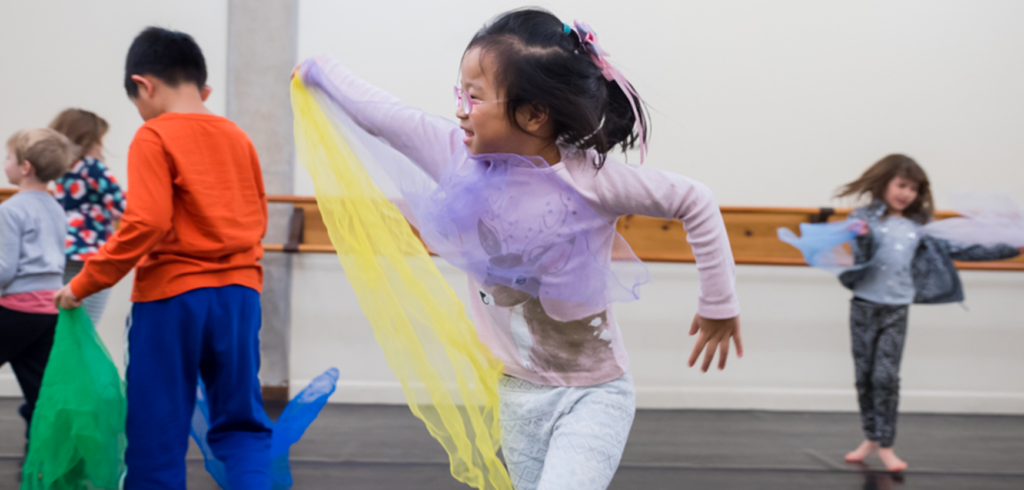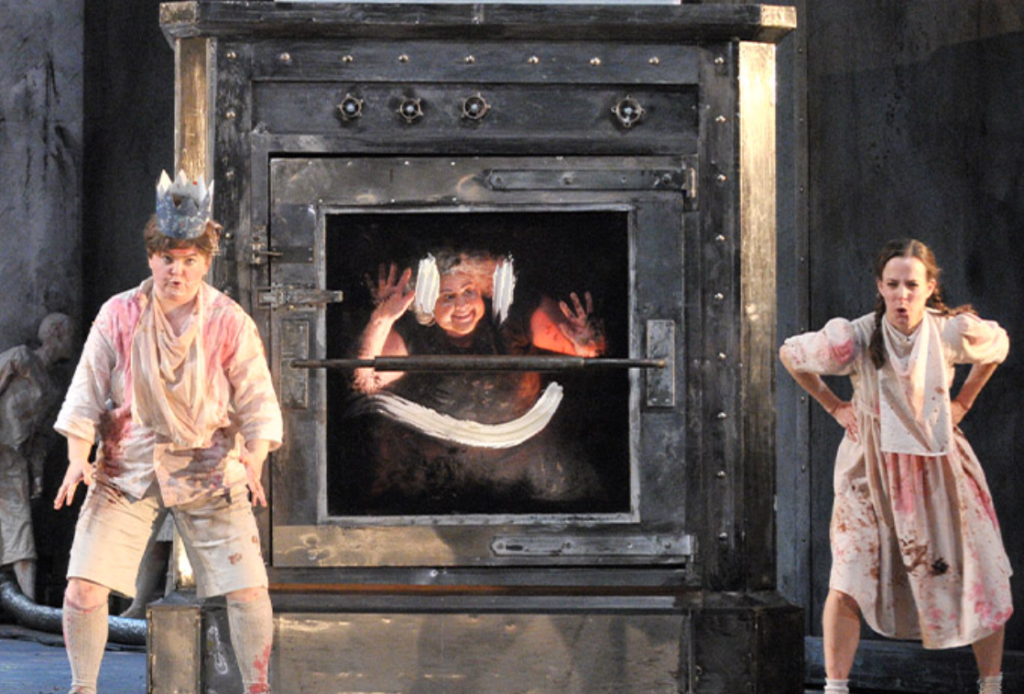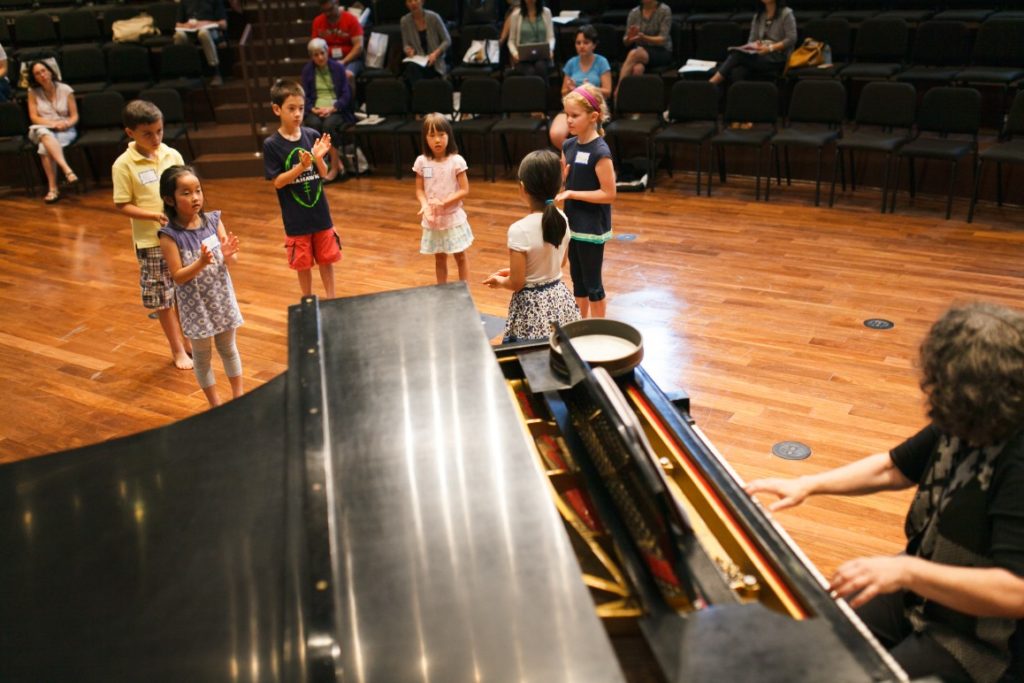
Lesson Plan: Dalcroze with Ages 3-6
Overview
This is a lesson adaptable for ages 3 to 6, mid-semester. The subject is Phrase & Form. This lesson is centered around the song “The Birdies Fly Away” (adapted from Humperdinck’s “Hänsel und Gretel”).
The musical goals include:
- Feel different phrase durations in arms; with the body; visually; and at the xylophone
- Sequentially experience, choose, and identify long and short phrases
- Count phrases in a song
The materials one needs for this class includes:
- hoops
- white board + chalk or markers
- drum
- printed scores

Lesson Sequence
Opening Circle
1. Trace rainbows in the air; experiment with faster, slower, bigger, smaller.
Can improvise explanatory lyrics here, e.g. “up and over over here, and…”
Changing the speed and placement of the circles can be an exercise that explores the relationships between Time-Space-Energy.
2. Trace rainbows with the phrases of the Hello Song. “How many phrases were there? Okay, let’s count.”
KEY: we don’t have to guess or be right and wrong in music class, we can just check!
Preparatory Exercise
In a park/forest: walk (or other run, lunge, etc.) from tree to tree: when we find one, pause and make a tree-shape. First, the students pick whether the next tree is farther away or closer. Then piano music decides.
This activity begins as a type of improvisation, where the students are in charge. Then it evolves to an aural reaction, where the piano decides the length of the phrases for the students.
…segue: “I see a bird up there!”…

Song
(back to sitting in a circle)
1. Show the students how to make birds flying with their hands. Improvise songs using the words “fly and fly and…” as the ‘birds’ fly around. When the teacher sings “back home,” put the birds in their nest (the lap).
2. The teacher changes the length of the birds’ trips by singing short and long phrases. If time, let students sing for the activity,or be responsible for singing “back home.”
Some kids love choosing the longest phrase possible, and some kids realize how funny short phrases can be.
3. Sing “The Birdies Fly Away“: Repeat the same game, but now use this melody above. “If the song says ‘home,’ be there; otherwise, fly around.”
4. Verbalize: which phrase is longer?
Available to ask, “how do you know?” and connect with opening games (we don’t have to know, we can try and find out).
5. Now fly around the classroom like a bird. When the song goes home, find your nest (a hoop laying on the ground).
Whereas before the students listened for the lyrics ‘back home,’ now they are listening for a type of authentic cadence. This changes the game from a verbal reaction to an aural reaction.
Try, practice, and ask questions: “Are you too early/late? Which one is the long phrase? Do you need to fly farther/closer?
Younger kids can have their grown-up be the nest, or switch and watch their grown-ups being the birds.
Applications

1. Sing “The Birdies Fly Away” & Draw. On the BOARD (I scribble a nest): the marker is the bird: Take turns and observe differences, choices, and visual trips/phrases.
2. Sing & Point. Look at SCORES (on the floor): How many phrases? Sing while tracing “rainbow” phrase-mark with finger (“yes, it’s very small, so we have to trace very slowly!”)
3. Now the XYLOPHONE will make up new melodies using the lyrics of ‘The Birdies Fly Away’. “What’s our pattern? yes: shoort, shoort, looooong” Say & Play. The words will tell you when to pause and take a breath.
Students not playing the xylophone may watch, listen, help say “short short long,” or show rainbows with their arms – it is their turn, too, to help!
There are lots of moments for students to improvise in this lesson, culminating in instrumental improvisation.
Goodbye Song
Use whatever tune you regularly use with your students. Consider adding a gesture or game relating back to the topic of the day: phrases!
Members of the Dalcroze Society of America can read the full article online, which was originally published in the Fall 2023 issue of Dalcroze Connections, Vol. 8 No. 1. Not a member? Join instantly online.
Thank you, Aaron, for all of the fresh ideas! This is the kind of this we should all be doing – I look forward to trying out your lesson plan when classes resume at the end of January.
Thanks Alice!
I hope you have fun with the song. It’s a wordy lesson-plan, but the song lyrics are so descriptive, they almost motivate the activities themselves.
Have fun!
Aaron